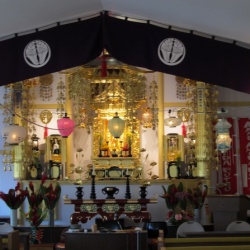Difference between revisions of "Brief history of symbolism in Buddhism"
| Line 1: | Line 1: | ||
[[File:IMG 2882.JPG|thumb|250px|]] | [[File:IMG 2882.JPG|thumb|250px|]] | ||
| + | |||
| + | |||
| + | |||
| + | |||
| + | |||
| + | |||
| + | |||
Many [[Buddhist symbols]] need to be considered within the {{Wiki|culture}} of the [[people]] who follow it. Therefore, many of the early [[symbols]] relate to {{Wiki|ancient India}} and can be found in [[Hinduism]] as well, although possibly with a somewhat different meaning. | Many [[Buddhist symbols]] need to be considered within the {{Wiki|culture}} of the [[people]] who follow it. Therefore, many of the early [[symbols]] relate to {{Wiki|ancient India}} and can be found in [[Hinduism]] as well, although possibly with a somewhat different meaning. | ||
| Line 6: | Line 13: | ||
In the second century BCE, [[people]] started to excavate [[Buddhist]] [[monasteries]] in rock, creating a large amount of artwork to withstand the ages. Probably the earliest typical [[Buddhist]] monument is the [[stupa]], which was often specially decorated. The first actual [[Buddha]] images appeared around the first century BCE, so until then the artwork was largely [[symbolic]] in [[nature]]. | In the second century BCE, [[people]] started to excavate [[Buddhist]] [[monasteries]] in rock, creating a large amount of artwork to withstand the ages. Probably the earliest typical [[Buddhist]] monument is the [[stupa]], which was often specially decorated. The first actual [[Buddha]] images appeared around the first century BCE, so until then the artwork was largely [[symbolic]] in [[nature]]. | ||
| − | With the [[appearance]] of [[Buddhist Tantra]] around the 6th century, a [[wealth]] of new artwork and [[symbolism]] appeared, as [[imagination]] and [[visualization]] [[form]] a major technique in [[meditation practices]]. From this [[moment]] on, a {{Wiki|pantheon}} of [[deities]] and [[protectors]] appeared, together with a vast collection of [[symbolic]] items, such as the [[vajra]] and [[bell]], [[mandalas]] etc.; see the page on [[Tantric]] [[Symbols]]. This [[tradition]] was mainly preserved in so-called '[[Tibetan Buddhism]]', and partially in the [[Japanese]] [[Shingon]] [[tradition]]. | + | With the [[appearance]] of [[Buddhist Tantra]] around the 6th century, a [[wealth]] of new artwork and [[symbolism]] appeared, as [[imagination]] and [[visualization]] [[form]] a major technique in [[meditation practices]]. From this [[moment]] on, a {{Wiki|pantheon}} of |
| + | |||
| + | [[deities]] and [[protectors]] appeared, together with a vast collection of [[symbolic]] items, such as the [[vajra]] and [[bell]], [[mandalas]] etc.; see the page on [[Tantric]] [[Symbols]]. This [[tradition]] was mainly preserved in so-called '[[Tibetan Buddhism]]', and partially in the [[Japanese]] [[Shingon]] [[tradition]]. | ||
[[Category:Buddhist Symbols]] | [[Category:Buddhist Symbols]] | ||
{{R}} | {{R}} | ||
[http://viewonbuddhism.org/general_symbols_buddhism.html viewonbuddhism.org] | [http://viewonbuddhism.org/general_symbols_buddhism.html viewonbuddhism.org] | ||
Latest revision as of 12:14, 5 January 2024
Many Buddhist symbols need to be considered within the culture of the people who follow it. Therefore, many of the early symbols relate to ancient India and can be found in Hinduism as well, although possibly with a somewhat different meaning.
The historical Buddha lived around the sixth century BCE, but no Buddhist artifacts are known from before the third century BCE. In the scriptures, it is mentioned that the Buddha did occasionally use images like the 'Wheel of Life' to illustrate the teachings. The first archaeological evidence, mainly of ornamental stone carvings, comes from the time of the Emperor Asoka (273 - 232 BCE), who converted to Buddhism and made it a popular religion in India and beyond .
In the second century BCE, people started to excavate Buddhist monasteries in rock, creating a large amount of artwork to withstand the ages. Probably the earliest typical Buddhist monument is the stupa, which was often specially decorated. The first actual Buddha images appeared around the first century BCE, so until then the artwork was largely symbolic in nature.
With the appearance of Buddhist Tantra around the 6th century, a wealth of new artwork and symbolism appeared, as imagination and visualization form a major technique in meditation practices. From this moment on, a pantheon of
deities and protectors appeared, together with a vast collection of symbolic items, such as the vajra and bell, mandalas etc.; see the page on Tantric Symbols. This tradition was mainly preserved in so-called 'Tibetan Buddhism', and partially in the Japanese Shingon tradition.
